In the past we have detected several differences between patched parblues (Turquoise, Indigo, ... Saphire?) and heterozygous Emeralds leading to the hypothesis that Emerald is not a parblue but, probably, an incomplete dominant mutation acting on feather structure. These findings were:
1. Anatomical psittacin distribution. Patched in parblues. Even colour in Emeralds.
2. Gradient distribution (at the feather and anatomical level) in patched parblues (maximal in coverts and head, and at the feather tip) and even colour in Emeralds.
3. Age dependent expression of psittacins: progressive increase in the expression of psittacins in parblues from fledging till adulthood. Final colour from feathering in Emeralds.
4. Hormonal dependent expression of psittacins: the expression of patched psittacins (coverts and neckring) is maximal after reaching adulthood in parblues. Patched psittacin is not expressed in Emeralds.
5. Different fluorescence under uv :hard to describe with words since it depends on the uv source and the observer eyes, but different type of fluorescence, described as yellowish for parblues and wild type, and as bluish for Emeralds. Fluorescence is already maximal in Emeralds at feathering and progressive in parblues till adulthood.
6. Different iridescence under natural ligth: Emeralds are brigth iridescent birds with an apparent colour changing with the angle made by the ligth-the bird-the observer. Parblues aren't (or at a much lower level).
7. Different hue under natural ligth : Emerald birds can appear greener or bluer depending on ligthing conditions, while parblues colour remains almost the same.
Now we can analyse the phenotype of DF Emeralds (see pics from Chris) and compare it to the phenotype of homozygous parblues. We will get some more findings pointing to Emerald as a structural mutation:
DF Emerald male

DF Emerald male

DF Emerald head

SF Emerald head

1. Head colour:
DF Emeralds show a brownish head colour while DF parblues show an increase in yellow pigments leading to a greener head colour. If Emerald was a parblue mutation, the DF Emerald should have shown a greener head (increase psittacin). If Emerald was a structural mutation the DF Emerald would be expected to show a darker phenotype than the SF bird (like for Dark and Violet) ... and this is the case.
2. Head brightness:
Brightness or iridescence depends on the ultrastructure of the outer feather cortex. Mutations acting on this structure would alter iridescence. SF Emeralds show a brigth head. This head brigthness is lost in DF birds (pics and Chris personal communication) allowing to conclude that a further alteration of feather structure in DF Emeralds destroys/changes the structure of the outer cortex and leads to a lost of iridescence (similar to the effect of SF Dark and DF Dark on the spongy zone). If Emerald was a parblue mutation (just acting on psittacin production) it would not alter iridescence in any way.
3. Black ring:
The black ring colour depends on the presence of foreground melanin in the cortex of the neckring feathers and not on the backgroung melanin (the melanin responsible of the blue colour together with the interference phenomenon). So mutations altering cortex structure would be able to affect foreground melanin deposition. We can see in some SF Emeralds a thinner black ring, and this effect is enhanced in DF Emeralds showing just a shadow of ring. If Emerald was a parblue mutation ... how to explain its action on ring melanin? Remember that the black ring is not affected in parblues, which only act on psittacins.
4. Red ring:
Psittacins (red and yellow) are deposited in the cortex. Whenever a mutation alters cortex structure we should expect a change in the deposition of these psittacins. The action of Emerald at this level could explain that no Emerald bird has ever shown a red ring (independently that it is a green or a blue series bird). If Emerald was a parblue mutation, a DF Emerald should have produced an increase quantity of yellow psittacins and, likely, a red ring (like for the DF patched parblues)... but this is not the case.
The strong points in this reasoning are the lost of iridescence and the lost of the black ring in DF Emeralds. These findings can be explained if we consider Emerald as a structural mutation acting on the outer cortex, but I would not be able to explain them considering Emerald as a parblue.
Regards
Recio
PS: Thanks to Chris for his generosity providing all these pics.


